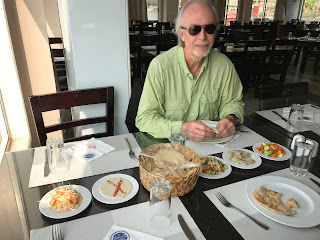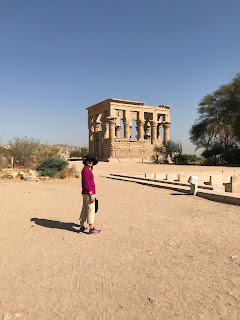After our last tour of old Cairo on Tuesday December 5th, we had one more night and then all day Wednesday to lounge around our hotel before our flight left for Toronto at 1:50 am Thursday. It wasn't the greatest flight time but at least it was a direct flight. Our Blue Sky rep had arranged for us to have late checkout from the hotel at 3 pm.
We tried to sleep in and did pretty well, although with jet lag and all our activities for over a week, we've been exhausted every night. We packed, eyed the activity on the street from our room and read our books. At 3 pm we checked out, stored our luggage and went down to the extensive spa area. We killed more time having steam baths and lounging by the side of the big jacuzzi pool. Eventually we went back to the dining room for a pizza. Our meal plan had ended at breakfast so we were back to our usual frugal travel habits.
Just before we left the hotel, a belly dancer started her routine in the lounge. Apparently, this happens every night but we were never up late enough to see it.
At 10 pm, a Blue Sky rep escorted us to our car and the driver took us back to the airport. Check-in, security and immigration clearance went smoothly so we were left with another couple of hours to kill in the airport. Parts of Cairo airport are not that clean or well maintained. A new airport will be built out of the city in a few years.
A few final thoughts about our Egypt trip:
In the past, we've sometimes been a little smug about how we backpack around on our own and don't need a group tour to get us places. Our India trip, because of sickness and travel hassles, was the first time that we really would have preferred a group tour. And we did take a group tour to China because we thought it would be a lot of trouble to do it any other way. In Egypt, we were ostensibly on a group tour and we thought before we left we'd be in a herd of 20 or so people all the time. That never happened. The other 2 couples we spent time with were great and we had lots of fun. The Blue Sky reps, drivers and guides were all fantastic. We saw and learned more in a little over a week than we could ever have seen on our own in a month. Plus we had a lot of fun doing it.
In easier countries, we'll continue to backpack on our own. However, we aren't as rigid as we once were about group travel. In future, we'll do what seems to fit best.
Tourism in Egypt is suffering mightily because of security concerns. Even the Government of Canada web site warns against non-essential travel to Egypt. We would not travel alone in the Sinai or in the desert near Libya. However, everywhere we went in Cairo and along the Nile seemed perfectly safe.
In general, it seems like Egyptians are thoroughly sick of the Muslim Brotherhood style of government with its strong mix of religious rules with politics. The Egyptians we met seemed very tolerant of other religions and customs while still maintaining a more conservative society than our own.
When you order a "Stella" in Egypt, you're not getting a Stella Artois. There's a local beer named Stella with a picture of a musician and a belly dancer on the can. It's actually pretty good beer.
Cairo traffic is very congested but the drivers aren't crazy. A fender bender is a distinct possibility at any time but we didn't have any near-death experiences.
Street vendors in Egypt are the same as those in other countries. As our guide Mohammed said, "They think all tourists are rich and stupid". They can be aggressive and annoying. Most of what they sell is made in China. The best advice is to not engage with them at all. Just ignore them.
Tipping in Egypt is important. It sometimes seems like everyone has their hand out, even washroom attendants in hotels and airports. Some are polite about it and some always want more no matter how much you give. The camel drivers at Giza and the horse-drawn carriage drivers in Edfu were particularly aggressive. Again, it's best to stay calm.
If all a tourist saw of Egypt was Cairo and the pyramids on the Giza plateau, they would likely have a very different perspective from ours. Cairo is big, dirty and congested. Luxor and Aswan are nice, clean cities with little traffic and pollution. Cruising the Nile is a great way to see the "real" Egypt of farms and small towns.
In our opinion, seeing the pyramids, temples and other artefacts of ancient Egypt should be on any traveller's bucket list. Our Egypt tour was one of the best trips we've ever taken.
We tried to sleep in and did pretty well, although with jet lag and all our activities for over a week, we've been exhausted every night. We packed, eyed the activity on the street from our room and read our books. At 3 pm we checked out, stored our luggage and went down to the extensive spa area. We killed more time having steam baths and lounging by the side of the big jacuzzi pool. Eventually we went back to the dining room for a pizza. Our meal plan had ended at breakfast so we were back to our usual frugal travel habits.
Just before we left the hotel, a belly dancer started her routine in the lounge. Apparently, this happens every night but we were never up late enough to see it.
At 10 pm, a Blue Sky rep escorted us to our car and the driver took us back to the airport. Check-in, security and immigration clearance went smoothly so we were left with another couple of hours to kill in the airport. Parts of Cairo airport are not that clean or well maintained. A new airport will be built out of the city in a few years.
A few final thoughts about our Egypt trip:
In the past, we've sometimes been a little smug about how we backpack around on our own and don't need a group tour to get us places. Our India trip, because of sickness and travel hassles, was the first time that we really would have preferred a group tour. And we did take a group tour to China because we thought it would be a lot of trouble to do it any other way. In Egypt, we were ostensibly on a group tour and we thought before we left we'd be in a herd of 20 or so people all the time. That never happened. The other 2 couples we spent time with were great and we had lots of fun. The Blue Sky reps, drivers and guides were all fantastic. We saw and learned more in a little over a week than we could ever have seen on our own in a month. Plus we had a lot of fun doing it.
In easier countries, we'll continue to backpack on our own. However, we aren't as rigid as we once were about group travel. In future, we'll do what seems to fit best.
Tourism in Egypt is suffering mightily because of security concerns. Even the Government of Canada web site warns against non-essential travel to Egypt. We would not travel alone in the Sinai or in the desert near Libya. However, everywhere we went in Cairo and along the Nile seemed perfectly safe.
In general, it seems like Egyptians are thoroughly sick of the Muslim Brotherhood style of government with its strong mix of religious rules with politics. The Egyptians we met seemed very tolerant of other religions and customs while still maintaining a more conservative society than our own.
When you order a "Stella" in Egypt, you're not getting a Stella Artois. There's a local beer named Stella with a picture of a musician and a belly dancer on the can. It's actually pretty good beer.
Cairo traffic is very congested but the drivers aren't crazy. A fender bender is a distinct possibility at any time but we didn't have any near-death experiences.
Street vendors in Egypt are the same as those in other countries. As our guide Mohammed said, "They think all tourists are rich and stupid". They can be aggressive and annoying. Most of what they sell is made in China. The best advice is to not engage with them at all. Just ignore them.
Tipping in Egypt is important. It sometimes seems like everyone has their hand out, even washroom attendants in hotels and airports. Some are polite about it and some always want more no matter how much you give. The camel drivers at Giza and the horse-drawn carriage drivers in Edfu were particularly aggressive. Again, it's best to stay calm.
If all a tourist saw of Egypt was Cairo and the pyramids on the Giza plateau, they would likely have a very different perspective from ours. Cairo is big, dirty and congested. Luxor and Aswan are nice, clean cities with little traffic and pollution. Cruising the Nile is a great way to see the "real" Egypt of farms and small towns.
In our opinion, seeing the pyramids, temples and other artefacts of ancient Egypt should be on any traveller's bucket list. Our Egypt tour was one of the best trips we've ever taken.























































